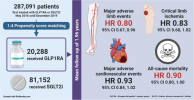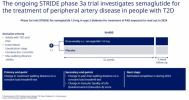Thanks. So basically I got diagnosed with a blood clot in my femoral artery march 21which was the result of having undiagnosed PAD. The claudication can be excruciatingly painful and infuriating, guess I was just wondering if you had any tips on how to get to 10k a day? (Without tears )
Uggggh - painful!
This is what has worked for me (really just standard guidance):
- Keep pushing the walking. Unfortunately, for me it really was no pain = no gain with this beast, in the early days at least.
I've always enjoyed walking and I was really frustrated at getting claudi-clobbered every few hundred metres. So I kept pushing it, basically walking as far as I could stand, resting for a few minutes & then doing it again, over & over, on most days.
What happened is that I pretty quickly started to develop a big array of collateral vessels, snaking all over my leg & bypassing the femoral artery, which has pretty much ceased to exist between groin and knee. Also, my calf muscles slowly got more efficient.
So the net effect is that fairly soon (like 2-3 months) things started to get much better, and really they have continued to improve in the 3+ years since then. I can walk for kilometres at ~120 steps/minute without any real claudication; just tiredness and heaviness in the calf and foot of the gammy leg - and hills continue to be tough.
That was just me & I don't know if you need to push it as hard as I did & do to get the same benefits. But looking at all the PAD walking-therapy studies, I can now walk way way further and faster than the groups involved, despite starting out at the same kind of level. So maybe it was necessary.
Should also say that I get a definite dopamine buzz from walking. So with the buzz and pretty rapid collateral-linked walking improvements, I was lucky that the pain/gain balance was favourable.
- Growing that collateral network was the big improvement for me. I believe that this "angiogenesis" response varies a lot between individuals. I got lucky, I think.
But also you can do think things to promote the growth. Obviously, no smoking. Get BP under control.
Getting LDL cholesterol as low as you can is important for collateral development as well as controlling atherosclerosis risks. PAD is just as serious as coronary artery disease etc, but it seldom seems to be treated that way by GP's. Unless there is some other medical reason not to, you should be on max dose statins (80mg atorvastatin per day in the UK, as first line) - it's great that the NHS England guidelines now make that explicit, for PAD as well as for CAD etc. Follow the standard heart-healthy dietary advice: sharply limit saturated fat, salt, refined carbs; eat lots of fruit, veg, legumes, nuts, seeds, plant/lean protein.
- Generally I don't think this thing gets treated & supported very well, particularly versus heart disease, and it seems that you usually need to deal with it yourself to a large extent. But if you think that a structured group walking program would be useful, maybe worth harassing your HCP's to see if you there is one available.



